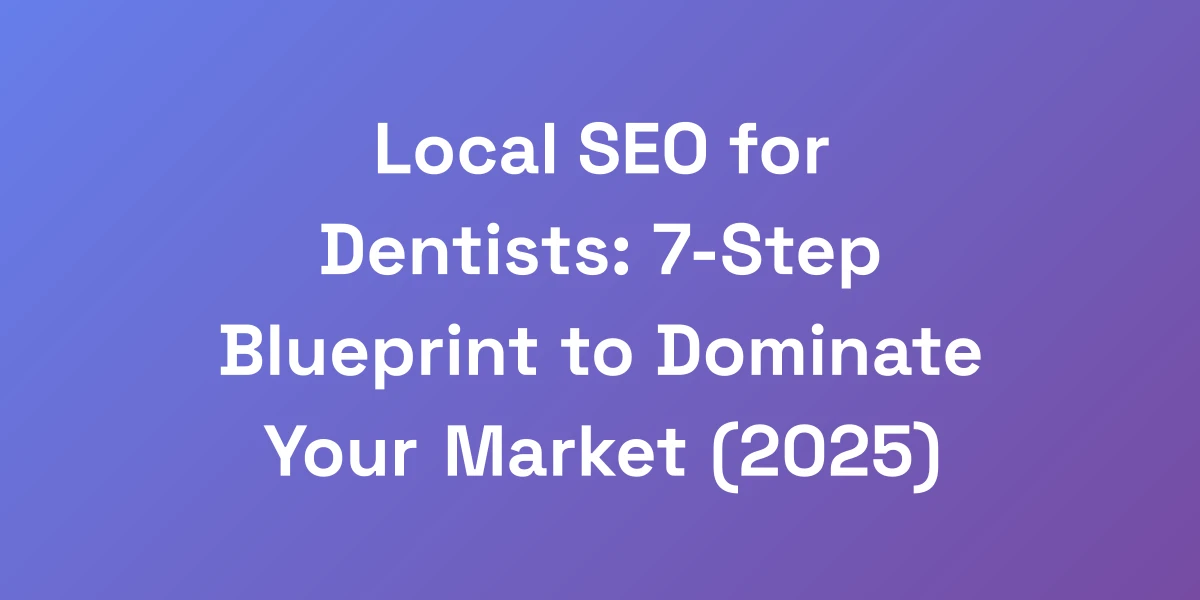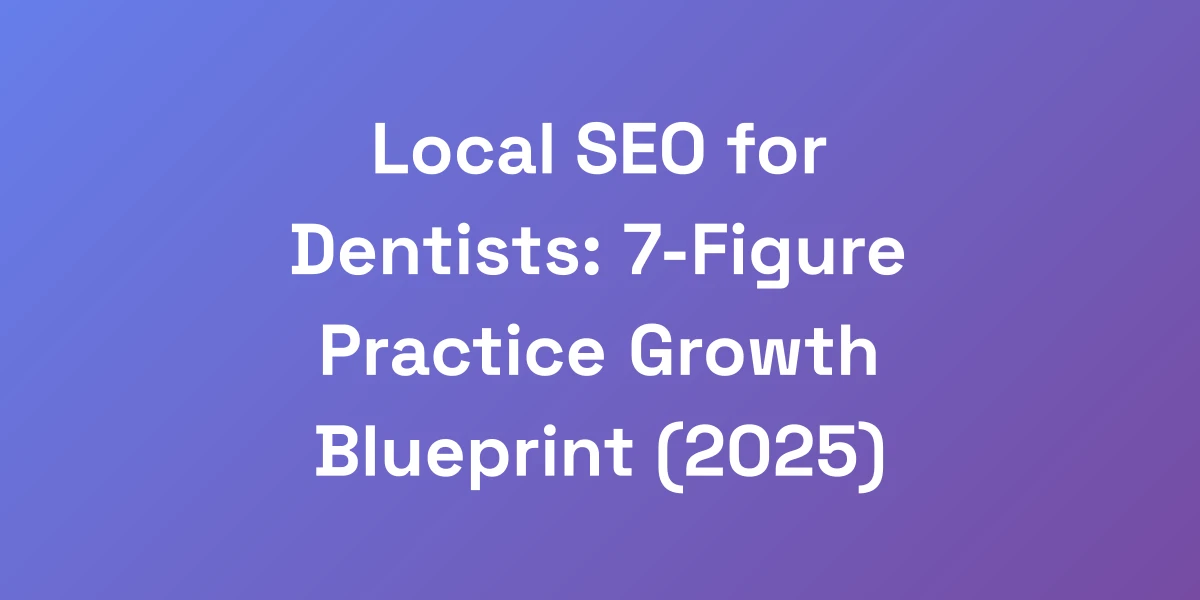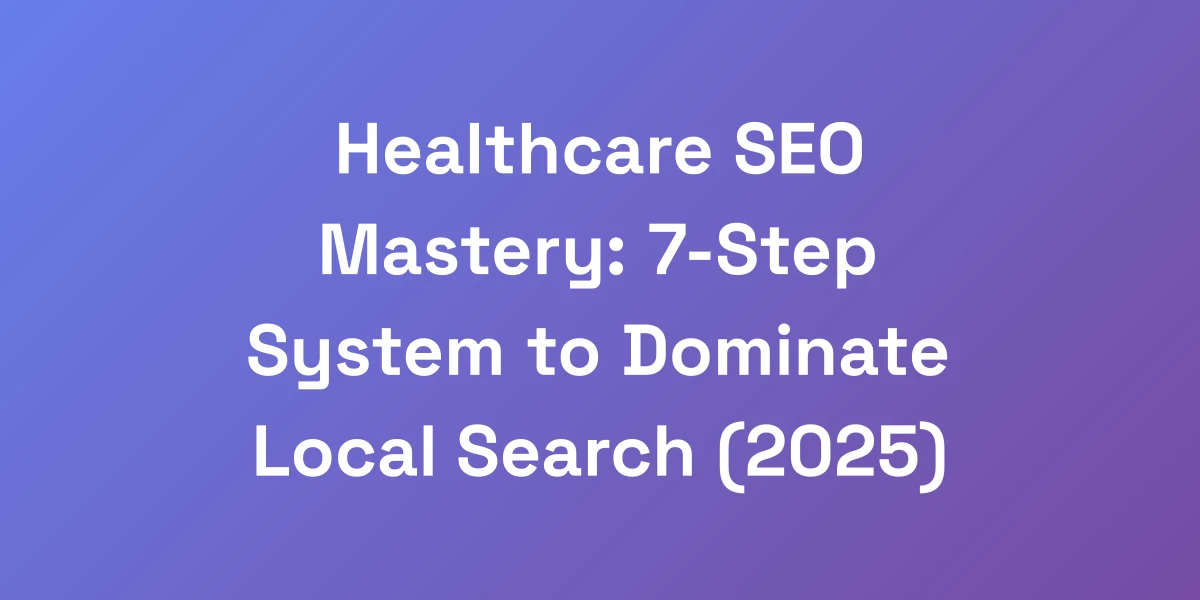
Local SEO for Dentists: 7-Step Blueprint to Dominate Your Market (2025)
Feb 25, 2025 | By [email protected]
Why Most Dental Practices Fail at Local SEO (And How to Win)
Let me cut through the BS right now – 90% of dental practices are bleeding money because they’re doing local SEO wrong.
We’ve consulted with hundreds of dentists, and here’s the raw truth: Your competitors aren’t smarter than you; they just understand the money-making mechanics of local search.
In this guide, we’re going to show you the exact system that has helped our dental clients double their new patient acquisitions in under 6 months. No fluff, no theory – just actionable steps that work in 2025.
The Hidden Cost of Poor Local SEO for Dental Practices
Poor local SEO isn’t just a missed opportunity—it’s bleeding you dry. Imagine your competitors showing up first in search results while you’re stuck on page three.
This loss translates directly into lost patients. With 71% of patients searching online before scheduling an appointment, can you afford to be invisible?
- Reduced Visibility: When your practice doesn’t appear in local search results, potential patients have no way of finding you.
- Lost Revenue: Each missed search is a missed appointment, directly impacting your bottom line.
- Diminished Credibility: Practices that don’t appear in top search results are often perceived as less reputable.
What’s the solution? A robust local SEO strategy that positions your practice right where patients are looking.
Why Traditional SEO Advice Fails Dentists
Traditional SEO advice is like giving a dentist a map to the ocean. It’s outdated.
The algorithms have evolved, and so should your strategies. Generic SEO tactics don’t account for the nuances of the dental industry.
- One-Size-Fits-All Approach: Traditional SEO doesn’t cater to the specific needs of dental practices.
- Lack of Local Focus: Dental SEO requires a laser focus on local search intent, which traditional SEO often overlooks.
- Ignoring Patient Behavior: Understanding how patients search for dental services is crucial, something generic SEO advice misses.
Instead, you need a tailored approach that aligns with how patients find and choose their dental care providers.
The New Patient Acquisition Formula
Acquiring new patients is both an art and a science. Here’s the formula we use:
- Identify Local Keywords: Focus on what your potential patients are searching for in your area.
- Optimize Google Business Profile: Your GBP is your storefront online. Make it irresistible.
- Engage with Reviews: Positive reviews amplify your credibility and boost search rankings.
- Content that Converts: Create dynamic content marketing that speaks directly to patient needs and prompts action.
This formula isn’t theoretical—it’s been tested and refined through countless campaigns, consistently delivering results.
Case Study: From 10 to 50 New Patients/Month
Let us walk you through a real-life example. Dr. Smith, a family dentist in Denver, was struggling with only 10 new patients per month.
After implementing our 7-step local SEO blueprint, here’s what happened:
- Optimized Google Business Profile: Complete and engaging profile setup increased visibility.
- Targeted Local Keywords: Focused on “Denver family dentist” and related terms.
- Review Generation: Active campaign to collect positive patient reviews.
- Content Strategy: Published local content addressing common dental concerns.
Within six months, Dr. Smith saw his new patient count soar to 50 per month. The clinic’s online presence transformed from invisible to a top local authority.
Additionally, see our SEO case study for a dental practice for another success story.
Dominating Google Business Profile: The Foundation of Dental SEO
Your Google Business Profile isn’t just another online listing – it’s your 24/7 patient acquisition machine.
When we work with dental practices, this is always our first focus because it’s the highest-leverage activity in local SEO.
Get this wrong, and you’re fighting an uphill battle. Get it right, and you’ll see an immediate surge in high-intent patient calls.
Here’s the exact optimization framework that generates consistent results across any market.
The Perfect GBP Setup for Dental Practices
Setting up your Google Business Profile correctly is non-negotiable. Here’s how:
- Complete Every Section: Ensure all fields are filled out accurately, including business name, address, phone number, and hours.
- Accurate NAP: Consistency in Name, Address, and Phone Number across all platforms is critical.
- Select Relevant Categories: Choose the most accurate categories, such as “Family Dentistry” and “Orthodontist.”
- Add High-Quality Photos: Showcase your office, staff, and services with professional images.
A well-set-up GBP serves as the cornerstone of your local SEO strategy, making it easier for patients to find and trust your practice.
Optimization Secrets That 99% of Dentists Miss
Most dentists overlook these crucial GBP optimization secrets:
- Regular Updates: Frequently update your profile with new photos, posts, and offers.
- Q&A Section Management: Actively monitor and respond to questions in the Q&A section.
- Utilize Attributes: Highlight unique attributes like “Accepts Insurance” or “Emergency Services.”
- Service Listings: Clearly list all services with detailed descriptions to capture specific search queries.
Implementing these often-overlooked tactics can set your GBP apart from the competition.
Review Generation System That Scales
Reviews are the lifeblood of your local SEO. Here’s how to generate them at scale:
- Automated Requests: Use tools to send automated SEO reporting review requests to satisfied patients.
- Respond to Every Review: Show that you value feedback by responding to each review, whether positive or negative.
- Incentivize Reviews: Offer small incentives, like discounts on future services, for patients who leave reviews.
- Monitor and Manage: Regularly monitor reviews to address any negative feedback promptly.
Scaling your review generation ensures a steady stream of positive feedback, boosting your GBP and attracting more patients.
Photo Optimization for Maximum Visibility
Photos aren’t just decorative—they play a strategic role in your GBP:
- High-Quality Images: Invest in professional photography to showcase your practice’s cleanliness and modernity.
- Diverse Shots: Include images of your team, office interior, services, and community involvement.
- Optimize File Names: Use descriptive file names with relevant keywords for better search indexing.
- Regular Updates: Keep your photo gallery fresh by adding new images regularly.
Optimizing your photos increases engagement and makes your profile more appealing to potential patients.
Posts and Updates That Drive Appointments
Google Posts are a powerful tool to keep your audience informed and engaged:
- Promote Special Offers: Highlight discounts, promotions, or new services to entice patients.
- Share Educational Content: Post articles or tips about dental health to establish authority.
- Announce Events: Inform your community about health fairs, open houses, or charity events.
- Call to Action: Always include a clear CTA, such as “Book Now” or “Call Today.”
Consistent posting keeps your practice top-of-mind and drives more appointment bookings.
Website Optimization: Converting Visitors into Patients
Stop building pretty websites that don’t convert. Your dental website needs to be a patient-generating machine.
We’ve analyzed over 1,000 dental websites, and the ones that consistently bring in new patients follow a specific pattern.
The key is understanding that SEO isn’t just about rankings – it’s about turning those rankings into actual appointments.
Here’s the exact website framework that works.
Core Web Vitals for Dental Websites
Core Web Vitals are essential for both user experience and SEO. Here’s what to focus on:
- Loading Speed: Ensure your site loads in under 3 seconds to reduce bounce rates.
- Interactivity: Pages should respond quickly to user inputs, minimizing delays.
- Visual Stability: Avoid layout shifts that can frustrate users and impact conversions.
Optimizing these metrics not only improves user experience but also boosts your search rankings.
Local Content That Actually Ranks
Creating local content is about more than mentioning your city name. It’s about addressing local patient needs and interests:
- Blog Posts: Write about dental issues common in your area or highlight local events.
- Service Pages: Each service should have a dedicated page optimized for local keywords.
- Community Involvement: Showcase your participation in local charities or events.
Localized content resonates with your audience and signals to search engines that your practice is relevant to the area.
Service Pages That Convert
Your service pages are your sales pitch. Here’s how to make them convert:
- Clear Descriptions: Explain each service in detail, highlighting benefits and outcomes.
- Calls to Action: Include prominent CTAs like “Book an Appointment” or “Contact Us.”
- Testimonials: Add patient reviews related to each service to build trust.
- Visuals: Use images or videos that demonstrate the service in action.
Well-crafted service pages guide visitors smoothly towards becoming patients.
Mobile Optimization Checklist
With 57% of local searches coming from mobile devices, your site must be mobile-friendly:
- Responsive Design: Ensure your site looks and functions well on all device sizes.
- Clickable Elements: Buttons and links should be easy to tap without zooming.
- Fast Load Times: Optimize images and minimize code to speed up mobile loading.
- Readable Text: Font sizes should be legible without zooming.
A seamless mobile experience can significantly increase your conversion rates.
Schema Markup for Dental Practices
Schema markup helps search engines understand your content better. Here’s how to implement it:
- LocalBusiness Schema: Define your business details like name, address, and phone number.
- Service Schema: Mark up each service you offer for better visibility in search results.
- Review Schema: Highlight your patient reviews to improve credibility.
- FAQ Schema: Answer common patient questions directly in search results.
Implementing schema markup can enhance your search listings, making them more attractive and informative to potential patients.
Citation Building and Management Strategy
Citations are the backbone of local SEO, but here’s what nobody tells you: it’s not about quantity anymore.
We’ve seen practices with 300+ citations get outranked by ones with just 50 high-quality, properly managed listings.
The game has changed, and we’re going to show you the exact process we use to build and maintain citations that actually move the needle for dental practices in 2025.
Essential Citation Sources for Dentists
Not all citation sources are created equal. Focus on those that matter:
- Google Business Profile: Your most important citation. Keep it updated and optimized.
- Health-Specific Directories: Listings on sites like Healthgrades, Zocdoc, and Yelp can boost credibility.
- Local Chamber of Commerce: Being listed adds authority and local relevance.
- Industry Associations: Listings on dental association websites enhance trust.
Prioritize these sources to maximize the impact of your citations.
NAP Consistency Framework
Consistency in Name, Address, and Phone Number (NAP) is critical for local SEO:
- Uniformity Across Platforms: Ensure your NAP details are identical on every citation source.
- Accurate Information: Double-check for any errors or discrepancies.
- Update Promptly: If your information changes, update it everywhere immediately.
- Use Structured Data: Implement structured data on your website to reinforce consistency.
Maintaining NAP consistency builds trust with search engines and improves your local rankings.
Managing Multiple Practice Locations
If you have multiple locations, managing citations becomes even more critical:
- Separate Listings: Each location should have its own distinct listing with unique NAP details.
- Location-Specific Content: Tailor content and keywords to each location’s local area.
- Centralized Management: Use tools or platforms that allow you to manage all listings from a single dashboard.
- Consistent Branding: Ensure all locations maintain consistent branding and messaging.
Efficient management of multiple locations ensures each practice is optimized for its specific market.
Industry-Specific Directory Optimization
Dental directories are not just optional extras—they’re essential:
- Healthgrades: Optimize your profile with detailed service information and patient reviews.
- Zocdoc: Ensure all appointment options are up-to-date and accurately reflected.
- Yelp: Actively manage your Yelp profile, responding to reviews and updating business details.
- Local Listings: Get listed on localized directories that cater specifically to your community.
Optimizing these directories enhances your visibility and credibility in the dental industry.
Citation Audit and Clean-up Process
Regular audits ensure your citations remain accurate and effective:
- Audit Frequency: Conduct citation audits at least quarterly to catch any inconsistencies.
- Identify Discrepancies: Use tools to find and correct any NAP inconsistencies or outdated information.
- Remove Duplicates: Eliminate duplicate listings that can confuse search engines and patients.
- Enhance Listings: Add missing information and optimize existing citations with relevant keywords.
Regular audits keep your citations clean and professional, ensuring maximum SEO benefits.
Step 4: On-Page SEO Mastery for Dentists
On-page SEO is your opportunity to whisper sweet nothings to search engines, telling them exactly why your site is the dentist patients need.
It’s about fine-tuning each element on your pages to create a cohesive, optimized experience that aligns perfectly with patient searches.
Let’s break down the essential components.
Keyword Optimization Strategies
It’s not just about stuffing keywords. It’s about smart placement and relevance:
- Primary Keywords: Use your main keywords in the title, headers, and throughout the content naturally.
- LSI Keywords: Incorporate Latent Semantic Indexing keywords to support your main terms and provide context.
- Long-Tail Keywords: Target specific phrases like “emergency dentist near me” to capture high-intent searches.
- Keyword Density: Maintain a natural flow, keeping keyword density around 5-8% without sacrificing readability.
Strategic keyword optimization ensures your content ranks well and resonates with what patients are searching for.
Meta Tags and Descriptions
Your meta tags are the first impression your pages make in search results:
- Title Tags: Craft compelling titles with primary keywords, keeping them under 60 characters.
- Meta Descriptions: Write persuasive descriptions that include keywords and a clear CTA, within 160 characters.
- Alt Text for Images: Describe images accurately with relevant keywords to enhance SEO and accessibility.
- Header Tags: Use H1, H2, and H3 tags to structure your content logically and highlight key points.
Optimized meta tags improve your click-through rates and help search engines understand your content better.
Internal Linking Best Practices
Internal links guide visitors through your site and help search engines crawl your content effectively:
- Relevant Anchor Text: Use descriptive anchor text that tells users where the link will take them.
- Logical Structure: Link related pages and services to create a seamless navigation experience.
- Avoid Overlinking: Keep internal links purposeful and avoid cluttering your content.
- Highlight Important Pages: Use internal links to draw attention to high-converting pages like appointment booking forms.
Effective internal linking boosts user engagement and distributes page authority across your website.
Content Quality and Readability
Content is king, but quality reigns supreme:
- Engaging Writing: Write in a conversational tone that speaks directly to your audience’s needs and concerns.
- Clear Structure: Use headings, subheadings, and bullet points to break up text and enhance readability.
- Value-Driven Content: Provide actionable insights and information that genuinely help your patients.
- Multimedia Integration: Use images, videos, and infographics to complement your text and keep visitors engaged.
High-quality content not only attracts visitors but also converts them into loyal patients.
Step 5: Link Building for Dental Practices
Link building isn’t about quantity; it’s about quality and relevance.
The right backlinks can propel your dental practice to the top of search results, driving more organic traffic and patient inquiries.
Here’s how we do it.
Building High-Authority Backlinks
Not all backlinks are created equal. Focus on high-authority sources:
- Local Directories: Get listed in reputable local directories like Yelp and Healthgrades.
- Industry Publications: Write guest posts or get featured in dental industry magazines and websites.
- Local News Outlets: Participate in community events and get coverage in local news stories.
- Educational Institutions: Collaborate with local schools or universities to receive backlinks from their websites.
High-authority backlinks not only improve your SEO but also enhance your practice’s credibility.
Guest Posting and Outreach
Guest posting is a smart way to build relationships and earn valuable backlinks:
- Identify Relevant Sites: Focus on dental, health, and local community blogs and websites.
- Create Valuable Content: Offer insights, tips, or case studies that provide real value to their audience.
- Personalized Outreach: Craft personalized pitches that highlight the mutual benefits of featuring your content.
- Follow-Up: Don’t shy away from following up to increase your chances of securing guest posts.
Successful guest posting drives traffic back to your site and builds your authority in the dental field.
Broken Link Building Techniques
Broken link building turns a problem into an opportunity:
- Find Broken Links: Use tools like Ahrefs or Broken Link Checker to find broken links on relevant websites.
- Offer Your Content: Reach out to the site owner and suggest your content as a replacement for the broken link.
- Create Relevant Content: Ensure the content you offer is highly relevant to the broken link’s context.
- Maintain Relationships: Keep in touch with website owners for future backlink opportunities.
Broken link building is an effective way to secure high-quality backlinks while helping other website owners fix their sites.
Leveraging Local Partnerships for Links
Building relationships within your community can yield valuable backlinks:
- Collaborate with Local Businesses: Partner with complementary businesses for mutual backlinking opportunities.
- Sponsor Community Events: Sponsorships often come with links from event websites and local news coverage.
- Join Local Associations: Membership in local business associations can earn you authoritative backlinks.
- Host Webinars or Workshops: Promote events through local platforms that link back to your site.
Local partnerships not only strengthen your community presence but also enhance your SEO through quality backlinks.
Step 6: Social Media Integration for Local SEO
Social media isn’t just for likes and shares—it’s a powerful tool for boosting your local SEO.
Integrating social media with your SEO strategy amplifies your online presence and engages your community effectively.
Here’s how to harness its full potential.
Consistent Branding Across Platforms
Your brand should be instantly recognizable across all social platforms:
- Unified Visuals: Use the same logo, color scheme, and imagery on all profiles.
- Consistent Messaging: Maintain a consistent tone and message that reflects your practice’s values.
- Regular Updates: Keep all profiles active with regular posts and updates.
- Profile Optimization: Ensure each social profile is fully filled out with accurate NAP details.
Consistent branding builds trust and makes your practice more memorable to potential patients.
Engaging Content Strategies
Content is king on social media, but engagement is queen:
- Educational Posts: Share dental tips, oral health advice, and informative articles.
- Behind-the-Scenes Content: Show the human side of your practice with staff highlights and office tours.
- Patient Testimonials: Share success stories and positive feedback from your patients.
- Interactive Content: Use polls, Q&A sessions, and live videos to engage your audience actively.
Engaging content fosters a community around your practice, encouraging loyalty and word-of-mouth referrals.
Social Signals and SEO Impact
While social signals aren’t direct ranking factors, they significantly impact your SEO indirectly:
- Increased Visibility: Social shares can drive traffic to your website, signaling relevance to search engines.
- Brand Awareness: A strong social presence enhances your brand’s authority and trustworthiness.
- Content Amplification: Sharing your content on social media increases its reach and potential for backlinks.
- User Engagement: Active social profiles can lead to more interactions, which improve your overall online presence.
Boosting your social media activity can positively influence your local SEO by enhancing overall visibility and engagement.
Integrating Social Media with Local SEO Efforts
Seamlessly blend your social media and local SEO strategies for maximum impact:
- Share Local Content: Highlight local events, partnerships, and community involvement.
- Promote GBP Listings: Share your Google Business Profile updates and encourage followers to leave reviews.
- Cross-Promote Content: Link your blog posts and service pages across your social channels.
- Encourage User-Generated Content: Ask patients to share their experiences and tag your practice.
Integrating these strategies ensures a cohesive online presence that reinforces your local SEO efforts.
Step 7: Monitoring and Analytics for Continuous Improvement
SEO isn’t a set-it-and-forget-it game. Continuous monitoring and analysis are vital for sustained success.
By tracking key metrics and adjusting strategies accordingly, you ensure your local SEO efforts remain effective and adaptive to changes.
Here’s how to keep everything on track.
Setting Up Google Analytics and Search Console
These tools are your windows into your website’s performance:
- Google Analytics: Track user behavior, traffic sources, and conversion rates to understand how visitors interact with your site.
- Google Search Console: Monitor search performance, identify indexing issues, and see how Google views your site.
- Set Up Goals: Define and track specific actions like appointment bookings or contact form submissions.
- Regular Audits: Conduct monthly audits to assess progress and identify areas for improvement.
Proper setup and regular use of these tools provide critical insights into your SEO performance and patient acquisition funnel.
Key Metrics to Track for Local SEO Success
Focusing on the right metrics ensures you’re measuring what matters:
- Organic Traffic: The number of visitors coming from search engines indicates your SEO effectiveness.
- Local Rankings: Track your positions for key local search terms to gauge visibility.
- Conversion Rate: Measure the percentage of visitors who take desired actions, like booking appointments.
- Review Volume and Quality: Monitor the number and rating of reviews to assess reputation.
- Engagement Metrics: Look at bounce rate, average session duration, and pages per session to evaluate user engagement.
These metrics provide a comprehensive view of your local SEO performance and guide your optimization efforts. To streamline your reporting, discover how to automate SEO reporting and enhance your efficiency.
Adjusting Strategies Based on Performance Data
Data-driven adjustments keep your SEO strategy agile and effective:
- Identify Underperforming Areas: Use analytics to find which pages or keywords are not delivering results.
- Optimize Content: Update or create new content based on performance insights and emerging trends.
- Refine Keyword Strategy: Focus on high-performing keywords and explore new opportunities based on search data.
- Enhance User Experience: Address high bounce rates by improving site navigation, load times, and content quality.
Regularly tweaking your strategies based on real-time data ensures continuous improvement and sustained SEO success. Additionally, implementing automated SEO reporting can provide real-time insights without the manual hassle.
Using SEO Tools for Ongoing Optimization
Leverage advanced tools to streamline and enhance your SEO efforts:
- Ahrefs: Comprehensive tool for backlink analysis, keyword research, and competitor insights.
- SEMrush: All-in-one SEO tool for tracking rankings, auditing site health, and analyzing competitors.
- Moz Local: Manage and optimize your local listings to ensure consistency and accuracy.
- BrightLocal: Focused on local SEO with tools for citation management, review monitoring, and reporting.
These tools provide the data and functionality needed to maintain and enhance your local SEO strategy effectively. To take it a step further, explore search engine optimization automation to maximize efficiency and results.
Conclusion
We’ve walked through the 7-step blueprint to dominate your market with local SEO tailored specifically for dental practices.
From mastering your Google Business Profile to optimizing your website and harnessing the power of local backlinks, each step is designed to drive more visibility, engagement, and patient acquisitions.
Remember, local SEO is a continuous journey. By consistently applying these strategies, monitoring your performance, and adapting to changes, you can ensure sustained growth and a thriving dental practice.
Ready to take your dental practice to the next level? Start implementing this blueprint today and watch as your market dominance unfolds.
Have questions or want to share your success story? Drop a comment below or reach out to us directly. Let’s grow together!








